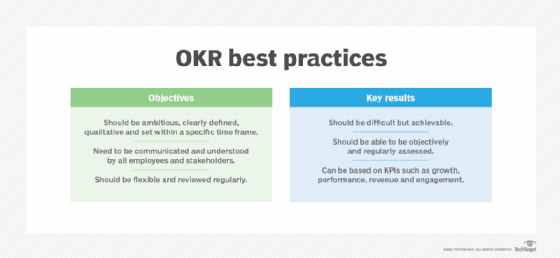
Olivier Le Moal - stock.adobe.co
OKRs vs. KPIs: Driving bold outcomes and measuring steady performance
KPIs track outputs, and OKRs focus on outcomes or changes in user behavior. Here's how business can use them together to measure outcome-driven progress and success.
Most companies wield powerful tools to measure progress and success, including key performance indicators (KPIs) and objectives and key results (OKRs). But organizations use OKRs and KPIs in different ways for different goals.
OKRs identify behavioral changes, while KPIs provide insights into performance metrics. Put another way, OKRs vs. KPIs is about outcomes vs. outputs.
What is an outcome-oriented OKR?
To benefit from OKRs, it's critical to focus on outcomes rather than outputs. Outcomes represent the change in customer/user behavior that occurs when customers select a product to get the job done. For example, if a company seeks to reduce call center costs, one output could be to change the user interface to improve usability, but the outcome would be a measurable reduction in customer support calls.
Companies often write OKRs that are output-driven rather than outcome-driven, which turns the company into a feature factory. Here is an example of output-driven OKR:
Objective: Establish a strong agile foundation.
KR 1: Train 90% of teams in agile fundamentals by Q2.
KR 2: Implement agile tools across 100% of development teams by Q3.
KR 3: Establish basic agile practices for 100% of teams by Q4.
Those KRs are time-bound and focus on quantifiable actions that lead to better collaboration and faster implementation, which are desired results for an agile transformation. However, they do not measure changes in customer/user behavior.
Reframe this as an outcome-driven OKR to emphasize the real outcome or change in user/customer behavior:
Objective: Establish a strong agile foundation.
KR 1: By Q2, 90% of teams report increased collaboration and faster decision-making.
KR 2: By Q3, 100% of teams use agile tools, resulting in a 20% reduction in project delays.
KR 3: By Q4, all teams follow basic agile practices, leading to a 15% bump in speed-to-market.
The reorientation around outcomes reflects the desired change in team behavior and the expected effect of agile adoption on productivity.
OKRs in action: A scenario
Consider a company that has a fitness app but is struggling with user engagement even though it regularly launches new app features.
To address the problem, the CEO shifts the business focus to outcome-oriented OKRs and sets new goals, such as increasing daily active users and boosting the percentage of users completing fitness goals. Instead of pushing more features, the team concentrates on ways to make the app essential to users' routines, such as a simplified interface and the addition of personalized reminders.
Within a few months, user engagement jumps. Tracking behavioral outcomes, rather than outputs creates a real beneficial impact.
How to apply strong OKRs with measurable outcomes
Let's look at some other examples of how to rethink OKRs with objectives that are driven by measurable outcomes.
Objective: Gain market share.
Bad KR: Send out an email marketing campaign to 10k customers.
Good KR: Increase the number of customers who open and act on the email by 20%.
Objective: Improve customer satisfaction.
Bad KR: Implement a new customer support process by Q2.
Good KR: Decrease customer service response times from 48 to 24 hours by Q2.
When to use OKRs vs. KPIs
OKRs are a goal-setting framework designed to focus teams on achieving ambitious and measurable goals. A typical OKR consists of an objective (what you want to achieve) and key results, which are the specific measures or signals that determine success.
KPIs are metrics that track ongoing business health. They measure performance in areas such as customer satisfaction, revenue growth and operational efficiency.
The following examples illustrate different ways to use OKRs and KPIs:
- OKRs aim for bold, specific outcomes in a short time frame, while KPIs track ongoing performance to maintain operational standards.
- OKRs focus on achieving particular objectives through three to five key results, whereas KPIs measure a broader range of business metrics.
- OKRs drive alignment by focusing on key goals, while KPIs need additional mechanisms to ensure consistency across teams.
How KPIs complement OKRs
A KPI such as the customer satisfaction (CSAT) metric provides a continual measure of customer satisfaction. Meanwhile, an OKR might push a team to improve that score by a specific amount in a specific time frame. Here's what that would look like:
KPI: Maintain a CSAT of 25%.
OKR:
- Objective: Improve customer support.
- KR 1: Increase customer satisfaction scores (CSAT) from 25% to 40% by the end of the first quarter.
In this scenario, the KPI provides continuous insight, while the OKR pushes for improvement in that metric over a set period. Both approaches have merit and complement each other.

Structuring OKRs for maximum impact
When creating OKRs, involve cross-functional teams and ensure that everyone is aligned with the same objectives. Here's a suggested structure to craft effective OKRs:
- Objective: What is the desired change or impact? For example, "Increase brand awareness."
- Key results: How will you measure that change in customer behavior? For example, "Grow social media mentions by 20% by the end of Q3."
It's also essential to align OKRs with broader business goals, or North Star metrics. For example, a North Star metric might be, "A 100% increase in active primary consumer checking accounts." Related OKRs could focus on improving customer onboarding and engagement.
Objective: Drive active use and engagement in new checking accounts.
KR 1: Increase the proportion of new accounts with one direct deposit or bill payment within the first 30 days.
KR 2: Boost login frequency among youth to an average of four logins per week in Q1.
The focus of that OKR is to change customer behavior (engagement with new accounts) to drive the overall business goal, which is to increase active checking accounts. Each key result is measurable and directly tied to the objective, to ensure the team stays focused on the outcome rather than the activities involved.
Different aspects of OKRs can change customer behavior
The key to effective OKRs is to focus on outcomes, the measurable behavior changes that lead to business impact, and not just track outputs. The following list illustrates how companies can use different aspects of OKRs to change customer behaviors:
- Communication. Clarified priorities help users experience more timely and relevant feature releases and improve overall user satisfaction.
- Motivation. Users engage more frequently with the platform as features align with their professional needs and goals.
- Alignment. Alignment with a specific mission enables a company to offer more personalized options to customers and increase the likelihood of a transaction.
- Connection. Customers benefit from more reliable and seamless services as distributed teams stay better connected and focused on user needs.
- Collaboration. Better collaboration enables users to experience faster and more integrated services, leading to better satisfaction.
- Transparency. Users see a more consistent experience across products as teams align more effectively on goals and priorities.
Organizations that align OKRs with broader business goals and use KPIs to monitor performance can stay focused on what matters most. When you craft outcome-oriented OKRs, teams can achieve meaningful progress that drives strategic growth and success.
Ashok P. Singh is a product coach, author and entrepreneur who helps companies simplify their agile software development and product development.










